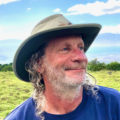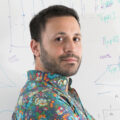2023
Human Relationships to Molecular Interactions: It’s Networks All the Way Down
-
Session 1: Networks, Human & Molecular
-
The Map Is Not the Territory: Redefining the Diagnosis and Treatment of Neuropsychiatric Conditions in the 21st Century
How we conceptualize disease informs how we treat it, as exemplified by approaches to treating diseases of the mind. More than a century ago, Edward Colwes wrote about the importance of steady progress towards a truth, informed by understanding clinical symptoms and the course of disease. The aspiration of using mechanistic insights of disease to guide development of novel therapeutics...
-
Next-Generation Targeting Has Organelle-Level Precision
Intracellular organelles are relatively autonomous sub-systems within the cell, whose activity and chemical composition reflect the cell’s metabolic state. Metabolism is altered in diseased or aging cells, reflected at the level of specific organelles within them. Often, introducing compensatory changes in organelles can restore cells to normalcy given the intrinsic feedback between cells and their organelles. Nature already targets the...
-
Coping with the Noisy Nature of Life in Teaching and Other Philosophical Ruminations
Klymkowsky’s goal for this talk is to illustrate how stochastic (noisy) processes influence all aspects of life and how they can be best introduced to students. Physics is often seen as the model for how science works, with its explanatory power implying that our universe is deterministic. However, many events, such as radioisotope decay, are unpredictable individually. Stochasticity is more...
-
Dissecting the Biological Complexity of Animal Regeneration
Under normal physiological conditions, the functions of many organs depend on the continuous destruction and renewal of their cells. Equally remarkable is the fact that the adult tissues and organs of many organisms can be fully restored after amputation. In fact, metazoans have evolved a series of renewal and repair mechanisms to respond to both trauma and normal wear and...
-
-
Session 2: Networks, Interpersonal & Developmental
-
Bad Sex: Reconciling the Personal, Political, and Biological
History's feminists and sexual revolutionaries have always had to grapple with an infuriating dilemma: Love and lust are major roadblocks to political clarity. It's never easy to live out dearly held values in one's personal life, a task that's especially messy for heterosexual women fighting for gender equality. The social and biological forces of sex, romance, and heartbreak introduce particularly...
-
Living Single in a World Built for Two
Single living is on the rise. Half of adults in the United States are unmarried and 28% of households in the United States are one person, surpassing the nuclear family as the most common household.
The rise of singles is not slowing, with one in four Millennials in the United States projected to never marry and half of single...
-
From Rare Diseases of the Skeleton to Treatment for All, and Back: Sclerostin and Its Inhibition
Osteoporosis, characterized by bone loss and skeletal fragility, affects hundreds of millions of patients worldwide, resulting in millions of fractures, reduced mobility, and frequent death. For many decades, the only treatments available aimed at reducing the resorption of bone (anti-resorptives: bisphosphonates, denosumab, estrogens). Treatments that increase bone formation (bone anabolics) have emerged later with the intermittent activation of the parathyroid...
-
The Story of Sophie’s Neighborhood: Moving Mountains for MCTO (Multicentric Carpotarsal Osteolysis)
A journey to find treatments for an ultra rare bone and kidney disease impacting less than 50 patients worldwide, including 5 year old Sophie Rosenberg.
-
-
Session 3: Networks, Information & Knowledge
-
Knowledge Overconfidence
Fernbach will describe research examining the interrelationships between opposition to expert consensus on controversial scientific issues, how much people actually know about these issues and science in general, and how much they think they know. Those with the greatest levels of opposition to the consensus have the lowest levels of objective knowledge but the highest levels of subjective knowledge. Studies...
-
Wearable Sensors and the Future of Health
Data from wearable sensors and other digital health technologies (DHT), including Apple Watch, Fitbit, and Oura Ring, are increasingly used in health and research. Continuous data streams like these may provide more granular information about biology, physiology, and health versus sporadic, non-continuous measurements. Sensor data are ripe for AI/ML; algorithms to detect anomalies and other bio-related phenomena in wearable sensor...
-
Decoding Brains: Imaging to Advance Mental Health
Functional magnetic resonance imaging (fMRI) provides powerful tools for mapping the human brain. However, because conventional fMRI provides little information about brain function in individuals, it is rarely used for clinical applications. Given that mental disorders and neurodegenerative diseases disrupt normal thought processes, the lack of any principled method for assessing thought patterns directly presents a serious limitation to our...
-
The Language of Song: AI-Powered RIFFIT Enhances Communication and Learning
For millennia, humans have used music to convey information. Songs and melodies heighten interest, facilitate comprehension, and promote long-term recall. The timing and variations in pitch and rhythm of a song lead the listener to process the information differently when compared to spoken or silently read information. Extensive research using neuroimaging highlights unique cognitive processing of content in song. ...
-
-
Session 4: Networks, Computational & Transcriptional
-
Five Questions About Generative AI and Health
Generative AI systems such as ChatGPT and Dall-E are the first artificial intelligence tools broadly embraced by the public. They have been overwhelmingly popular; ChatGPT reached a million users within five days of its November 2022 release; and by January 2023 50% of Americans say they had seen AI generated text, and 12% had generated some themselves. Credible estimates...
-
AI-Driven Biomedical Discoveries Using Observational Data
Observation is the starting point of discovery. Based on observations, scientists form hypotheses that are then tested and evaluated. In the information-age, trillions of observations are being made and recorded every day – from online social interactions to the emergency room visit. With so much data readily available, generating hypotheses using a single scientist’s mind is no longer sufficient. Instead,...
-
Genomes Packaged to Perfection, in All Domains of Life
All eukaryotes organize their DNA into nucleosomes, consisting of an octamer of the four core histone proteins H2A, H2B, H3, and H4, around which 147 base pairs of DNA are wrapped in two tight superhelical turns. Histones were an early acquisition in eukaryogenesis that allowed for massive genome expansion, a prerequisite for the diversity observed in modern-day eukaryotes. They are...
Save the Date!
17th Annual GoldLab Symposium
May 14-15, 2026
-
Living in the Fast Lane: Accelerated Copying of Genetic Information with Aging
Physiological homeostasis becomes compromised during ageing, as a result of impairment of cellular processes, including transcription and RNA splicing. However, the molecular mechanisms leading to the loss of transcriptional fidelity are so far elusive, as are ways of preventing it. Beyer’s and Papantonis’ team profiled and analysed genome-wide, ageing-related changes in transcriptional processes across different organisms: nematodes, fruitflies, mice, rats...
Presented By:
-

































